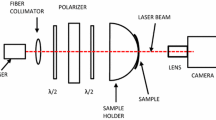Abstract
In plywood production, human operators find it difficult to precisely monitor the spread rate of adhesive in real-time. In this study, macroscopic fluorescence was used to estimate spread rate (SR) of urea formaldehyde adhesive on birch (Betula pendula Roth) veneer. This method could be an option when developing automated real-time SR measurement for plywood or processes. Estimation of SR was shown where adhesive was spread uniformly and also where adhesive was spread as lines. For uniform spreading, average intensity of the fluorescence image predicted the SR of adhesive well, with an R2 of 0.97 and root mean square error (RMSE) of 13 g m−2. For line-spread adhesive, line average intensity and width were used to estimate SR, and all these features predicted SR well. Furthermore, adhesive penetration into veneer over time could be detected from fluorescence images taken over time.






Similar content being viewed by others
References
Bekhta PA, Marutzky R (2007) Reduction of glue consumption in the plywood production by using previously compressed veneer. Holz Roh Werkst 65(1):87–88
Bekhta PA, Hiziroglu S, Shepelyuk O (2009) Properties of plywood manufactured from compressed veneer as building material. Mater Des 30(4):947–953
Donaldson L, Bond J (2005) Fluorescence microscopy of wood. Scion, Rotorua, New Zealand. (CD_ROM)
Frihart CR (2004) Adhesive interaction with wood in Fundamentals of Composite Processing. In: Proceedings of a workshop, Nov 5–6, 2003, Madison, WI. Gen. Tech. Rep. FPL-GTR-149. USDA, For Serv For Prod Lab
Gavrilović-Grmuša I, Miljković J, Điporović-Momćilović M, Radošević G (2008) Penetration of urea-formaldehyde adhesives in wood tissue part I: radial penetration of UF adhesives into beech. Bulletin of the Faculty of Forestry 98. University of Belgrade—Faculty of Forestry, Belgrade, pp 39–48
Gollob L (1989) The correlation between preparation and properties in phenolic resins. In: Pizzi A (ed) Wood adhesives chemistry and structure. Marcel Dekker, New York
Johnson SE, Kamke FA (1992) Quantitative analysis of gross adhesive penetration in wood using fluorescence microscopy. J Adhes 40:47–61
Lakowicz JR (1999) Principles of fluorescence spectroscopy. Kluwer Academic/Plenum Publishers, New York
Marra AA (1992) Technology of wood bonding. Principles in Practice. Springer, New York
Mbachu RA, Congleton TG (2004) NIR spectroscopic monitoring of resin-loading during assembly of engineered wood product. United States Patent, Patent Number US20040094851 A1
Modzel G, Kamke FA, De Carlo F (2011) Comparative analysis of a wood: adhesive bond line. Wood Sci Technol 45(1):147–158
Morris HR, Munroe B, Ryntz R, Treado PJ (1998) Fluorescence and Raman Chemical Imaging of Thermoplastic Olefin (TPO) Adhesion Promotion. Langmuir 14:2426–2434
Nozaka Y, Katsuta T, Masahiko C, Miyama H (1991) Method and device for detecting objects containing fluorescent substances. United States Patent, Patent Number 5,030,833
Plinke B, Ben-Yacov D (2010) Detection of adhesives on wood surfaces: spatially resolved monitoring of adhesive application. Adhes Adhes Sealants 7(4):25–29
Qiang G, Shi S, Shifeng Z, Jianzhang L, Kaiwen L (2011) Improved Plywood Strength and Lowered Emissions from Soybean Meal/Melamine Urea-Formaldehyde Adhesives. For Prod J 61(8):688–693
Schmidt M, Knorz M, Wilmes B (2010) A novel method for monitoring real-time curing behaviour. Wood Sci Technol 44(3):407–420
Sernek M, Resnik J, Kamke FA (1999) Penetration of liquid UF adhesive into beech wood. Wood Fibre Sci 31(1):41–48
Acknowledgments
The authors would like to acknowledge the financial assistance provided by the Energy Efficient Wood Processing and Machining project. This project forms part of the Multidisciplinary Institute of Digitalisation and Energy (MIDE), a research program on digitalisation and energy technology at Aalto University, that carries out important long-term projects aimed at creating high-level expertise, strengthening teaching and increasing the competitiveness of Finnish business and industry. Special thanks are also extended to Koskisen Oy (Järvelä, Finland) for providing materials for this research.
Author information
Authors and Affiliations
Corresponding author
Rights and permissions
About this article
Cite this article
Antikainen, T., Rohumaa, A., Hunt, C.G. et al. Estimating the spread rate of urea formaldehyde adhesive on birch (Betula pendula Roth) veneer using fluorescence. Eur. J. Wood Prod. 73, 69–75 (2015). https://doi.org/10.1007/s00107-014-0864-y
Received:
Published:
Issue Date:
DOI: https://doi.org/10.1007/s00107-014-0864-y




